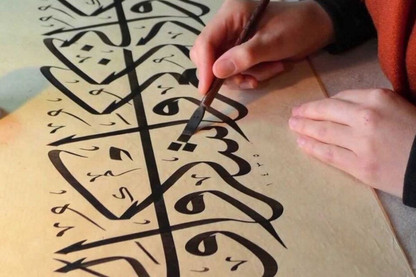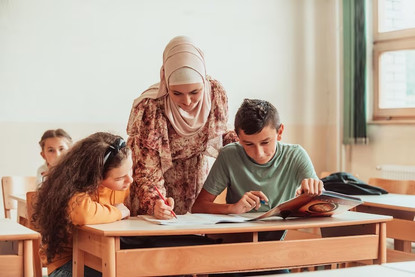Teach the Beauty of Arabic Calligraphy: Creative Project Ideas
Arabic calligraphy is not just beautiful writing, it's a sacred art that contains a delicate harmony of religion, language, and imagination. Rooted in Arabic, this ancient art has called to life Qur'anic manuscripts, mosque walls, and Islamic art for centuries. Far more than pleasing to the eye, Arabic calligraphy is a very spiritual art form, with each letter composing a written expression of respect and consideration.
In this article, we will discuss effective ways of including Arabic calligraphy in school art projects, such as basic instructional methods, spiritual contemplation, printable templates and even ideas on how to display the artwork in a creative manner or use the project as a fundraiser (exhibits).
What is Arabic calligraphy art called?
Arabic calligraphy is "Khatt Arabi" (الخط العربي) in Arabic, literally an Arabic line or Arabic writing. It is a way of inscribing Arabic letters in elegant and harmonious form. It evolved over centuries as one of the most sacred traditions of Islamic civilization.
A number of the most common Arabic language calligraphy styles have their own personality and history:
- Kufi (Kufic): The oldest and most geometric of all, used in the early Qur'ans manuscripts and building architecture.
- Naskh: Well-proportioned and sharp, and used extensively in printed book copies of the Qur'an and text books.
- Thuluth: Ornate and refined, with wide sweeping curves, and used extensively for mosque and monument calligraphy.
- Diwani: Official script developed in Ottoman courts, used for formal and imperial writing.
- Ruq'ah: Simple, modern, and easy to learn, and thus ideal for beginners and use in schools.
These different forms of calligraphy which calligraphy muslim artists have developed reflect the richness and diversity of Islamic civilization. By introducing children to the beauty of Khatt Arabi, parents and educators are not just teaching them the beauty of the Arabic language, but the centuries-long dedication and artistry that are incorporated into each and every letter.
Explore Arabic Books that help you learn the fundamentals of the Arabic script and calligraphy styles.
Why Teach Arabic Calligraphy in Islamic Homes and Schools
Spending time with children creating Arabic calligraphy is a highly satisfying method of engaging children with their religion and with their language. It is more than a craft: It is a gateway to the soul of Islamic culture, where each curve and each line is beautiful and meaningful.
In Islamic schools, when a child studies Arabic calligraphy art as a course of study, he or she is not only studying fine motor skills and concentration; he or she also develops an appreciation for the Arabic script. When the child copies and traces verses, he or she realizes how beautiful Arabic language calligraphy is and learns Qur'anic lessons of patience and discipline.
Parents can make calligraphy into a peaceful home activity, having children decorate their study table or prayer room with inspirational phrases such as "Bismillah" or "Alhamdulillah." These little exercises make learning personal, filling it with imagination as well as awareness of religion.
Besides, calligraphy education among Muslim kids gives them love for Allah's written word. It turns class in art into time for contemplation and remembrance, making young students understand that love and beauty can coexist in the lovely script of Arabic letters.
Basic Arabic Calligraphy for Kids and Beginners
You don't need to be an artist to start teaching calligraphy in Arabic, only patience, good materials, and love for the Arabic script. At home or in class, children can learn to easily start building the simple shapes and strokes that make up this beautiful art.
1. Tools and Materials Needed
Starting Arabic language calligraphy is easy with simple materials:
- Calligraphy pens or markers: bamboo qalam pens or broad-nib pens are just great.
- Ink or wash paint: ideal for class art activities.
- Practice sheets or calligraphy paper: the paper should be smooth enough such that ink flows smoothly.
- Printable templates: to trace letters and words in Arabic (you can download free online or create student-specific ones yourself).
Lead students to personalize their calligraphy set by decorating pen holders or folders, it gives them pride in their learning experience. Check out Stationery & Gifts at Madinah Media for quality art supplies, pens, and creative materials for your classroom.
2. Teaching First Strokes and Letters
Start with fundamental letter shapes from the Arabic alphabet. Demonstrate how each letter's shape is unique based on the position within a word. Teachers can teach students simple exercises:
- Tracing large Arabic letters.
- Practicing horizontal strokes and curves.
- Writing small words such as Salam, Noor, or Bismillah.
By repeating these forms, students master control and confidence, critical skills for progressing in Arabic calligraphy art.
3. Turn learning into play
To create lessons that are enjoyable, add art with theme or story. For example:
- "Write and Decorate": Request students to write an Arabic term and ornament it with colors or Islamic geometric designs.
- "Verse of the Week": Select a simple, memorable verse from the Qur'an that students can write nicely and display.
- "Arabic Family Names": Children like writing their name or family members' names in Arabic calligraphy and let their parents show off their work.
Active projects like these promote a passion for learning and develop an enduring bond with the centuries-long tradition of calligraphy as acquired by Muslim teachers for centuries.
Creative Classroom or Home Project Ideas
Once the basics of Arabic calligraphy are learned, all that is left is imagination! At school, or at home, calligraphy is just one of the countless activities that are fun and combine art, religion, and community responsibility. Homemade projects allow students to learn the beauty of Arabic calligraphy art without responsibly declaring their love of the Arabic language.
1. Qur'anic Verse Posters
Have students select a short Qur'anic passage such as "Inna Allaha ma'a al-sabireen" (Indeed, Allah is with the patient) and write in bold script calligraphy. Students may also add watercolor washes, geometric patterns, or floral designs inspired by Islamic art in the background. These bookmarks make great additions to classroom displays showing beauty and religion. Get beautifully designed Holy Quran copies to inspire verse selections for your students’ art projects.
2. Calligraphy Bookmarks
An easy delight for everyone, students can print out Arabic words such as Rahma (mercy), Sabr (patience), or Noor (light) on tiny cards or strips of paper. To add a more professional finish, they can trim or border the bookmarks with gold, or add a tassel. These bookmarks are an excellent inclusion in school events or calligraphic Muslim artwork exhibits.
Pair this activity with creative Toys & Games or small craft sets for kids that make calligraphy learning more enjoyable.
3. Ramadan and Eid Greeting Cards
Let the students create greeting cards to capture precious moments. An elegant lettered "Ramadan Kareem" or "Eid Mubarak" in Arabic calligraphy can add a personal and warm touch. Parents will hold them dear as keepsakes and can be presented to someone as a secret treasure, to encourage them to think creatively during these holy days.
4. Collaborative Wall Art
For group work, ask the students to add one letter or word to create a large wall mural of a Qur'anic verse or inspirational quote like "Iqra" ("Read"). The activity promotes teamwork and provides students with a sense of how all the efforts result in a larger artistic message.
5. Calligraphy-Inspired Crafts
Stretch imagination beyond paper:
- Paint calligraphic letters on canvas tote bags or coffee mugs.
- Create wooden plaques with names or verses.
- Use recycled materials in the production of environmentally friendly art.
Such creative applications of Arabic calligraphy art enhance creativity and sustainability without compromising timelessness.
Finding the Spiritual Dimension of Calligraphy in Islam
Arabic calligraphy is not just a technique of art; it's a piece of worship. Muslim calligraphers down the centuries have used graceful lines and flowing scripts to preserve and hold sacred the word of Allah. Each stroke of the pen in the art of Arabic calligraphy symbolizes respect for the word of God, so ordinary writing becomes ibadah (worship).
The Arabic script was chosen as the vehicle for conveying the Qur'an, imbuing Arabic calligraphy with the religious character of the language. As students are reproducing Allah's names or verses, they're not just practicing their lettering; this is a prayerful exercise conditioning them to think and maintain concentration.
For children, learning calligraphy is a calming way of accessing the Qur'an and Arabic writing. The deliberate, measured act of penning out every letter brings peace and concentration, basically an easy meditation. Teachers and parents can use this art to remind their students that Islam most often offers beauty and worship side by side.
Furthermore, studying calligraphy with Muslim teens makes them realize that art can be sacred, meaningful, and extremely religious. By combining spirituality with imagination, Arabic calligraphy allows them to understand the Qur'an not just as sentences to read, but as a piece of beauty to view.
Having a Calligraphy Exhibition or Fundraising Event
Showing Arabic calligraphy exhibitions is a cost-effective means of celebrating students' imagination and fostering community spirit. Starting from a small class exhibition to a large school exhibition, such events enable children to witness their work being appreciated and admired, and that Islamic art is beautiful and important.
1. School or Community Calligraphy Gallery
Transform a school corridor or multi-purpose room into a students' art mini-gallery. Post Qur'anic verse posters, sign artwork, and class-created greeting cards. Encourage teachers to invite parents, local artists, and even imams to attend the event and appreciate the beauty of Arabic calligraphy art.
To make it personal, the students can put short written descriptions next to each piece of work, what word or verse they employed, and what it means to them. This adds a reflective, personal element to the display.
2. Purpose-based Fundraising
- Use your Arabic calligraphy display as a cause-related fundraising campaign.
- Sell bookmarks produced by students, calligraphy pieces of artwork mounted on frames, or greeting cards.
- Organize a live calligraphy show in which parents donate or auction art.
- Give to local charities, class art, or Qur'an classes.
They do more than educate children about giving; they educate them that their talent can make a difference in their world, a lesson with Islamic implications that are deep.
3. Online or Virtual Exhibitions
For home students in districts or communities, organize an online calligraphy show.
Post scanned or photographed projects on a simple website, blog, or social media site. Add Qur'anic background recitations, gentle nasheeds, or descriptions of every project. This avenue opens up the audience for Arabic language calligraphy and allows families worldwide to get a glimpse of the beauty in students' projects.
Free Resources and Printable Templates
Beginning Arabic calligraphy doesn't have to be costly or complicated. Parents and teachers can introduce this art into homes and schools with ease using the right equipment. From downloadable worksheets, practice sheets to numerous other devices, there are a lot of materials available to help students learn the magnificence of the Arabic script in phases.
1. Printable Calligraphy Practice Sheets
Provide students with traceable Arabic alphabet worksheets to lead them to learn about the movement and balance of the letters. Start with larger simple shapes, and gradually reduce to smaller more elaborate scripts. Use these sheets as homework and class exercises.
2. Step-by-Step Calligraphy Guides
Seek out starting Arabic language calligraphy books dealing with pen angles, ink control, and letter crossing. Most guides have brief exercises and encouraging writing practice that inspire students. Teachers also can display sample work from these guides on classroom walls for inspiration.
Browse Madinah Media’s English Books and Kids & Teens sections for calligraphy and Islamic art guides suitable for all ages.
3. Creative Templates for Projects
Printable Qur'anic verse posters, Eid decorations, or greeting card designs provide a means to apply their skills in something creative. Pre-set templates provide an effortless method of converting lessons into religious-purpose art activities, combining learning with religion-driven creativity.
4. Where to Find Quality Resources
For a variety of well-designed calligraphy books and Islamic art materials, and Islamic education textbooks, try Madinah Media.
Visit Madinah Media to explore Arabic Books, English Books, and Schools resources designed to make Arabic calligraphy both inspiring and educational.
Their Islamic educational materials and art material selection give parents, students, and teachers quality books and authentic resources that render learning even more applicable to the beauty of Arabic calligraphy art. Whatever you may be looking for in terms of beginning books, spiritual art books, or lesson plans, Madinah Media offers a range of materials to help you learn in a purposeful and inspiring way.
Conclusion: Call Forth Creativity, Faith, and Bond through Arabic Calligraphy
Introducing art lessons with Arabic calligraphy is not just a form of design exercise; it's a work of building faith, focus, and love for the Arabic language in children. Each pen movement is a work of blending art and spirituality, and children can express their love for Islam with grace and accuracy.
If you're ready to bring the beauty of Arabic calligraphy art into your home or school, go no further than Madinah Media, your first source for Islamic educational resources, calligraphy books, and creative stationery.
Discover tools that open minds, welcome faith, and respect the timelessness of calligraphy in Muslim tradition.
Make every letter you write a symbol of remembrance, beauty, and awe.
















